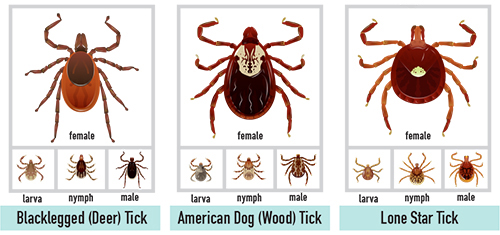About Ticks
Tick borne illnesses are one of the few health hazards that we need to be vigilant about in our bioregion. Lions and tigers and bears? Not really. Venomous snakes, sharks, crocodiles, or water buffalos? Nope.
The unpeopled temperate forests of upstate New York are among the safest natural areas on the planet. For us, it’s the littlest things that pose the most common threats. But that’s no reason to let our awareness down. Ticks are the sneakiest predators of them all. The microscopic organisms they carry are no joke.

But we can prevent tick-borne illnesses if we practice excellent prevention habits:
- frequent scans of exposed body areas and
- daily full-body checks, followed by
- prompt and careful removal of all ticks
Living in upstate NY requires good tick-checking habits whether you go outside or not.
Having to check for ticks is not a punishment for adventuring out in the woods. It is just a fact of living in this part of the world at this time in history. Sitting on the couch all day will not save you either.
You have teeth – you brush them! You live in upstate NY – you check for ticks!
Tick checking is actually a small price to pay for the numerous benefits of spending time in the natural world. And the side effects of teaching kids good tick-checking habits are pretty awesome too: They get to know their bodies really well. They get to take responsibility for their well-being in the world – a little practice for a lifetime of independence and self-care. They learn to identify and respond to real risks.
We will do our very best to support you and your family in good preventative habits!
Our promise to you is that we will manage the risk of tick-borne illness as best we can, and that we will encourage you and remind you and your children to do the same.
This is what we commit to:
- When your kids are having amazing, life-affirming experiences out in nature with us we will frequently talk about ticks.
- We will do our best to educate kids about the facts without frightening or disturbing them.
- We will make time to do frequent safety checks; scanning our outer layers and exposed skin for ticks.
- We will pay attention to conditions that might create tick hot spots, where tick numbers are increased, and we will avoid such areas when we discover them.
- We will provide private, well-lit spaces with mirrors for kids to do self-checks if they suspect having a tick under their clothing.
- For overnight camps, we will provide private, well-lit spaces with mirrors for doing self-checks, AND we will require all campers to take turns doing full-body self-checks before and after sleeping.
- We will provide proper tick-removal instruments and assist with campers removing ticks as needed.
- We will communicate with you, parents and caregivers, about any tick-bite exposures that involve your campers during camps and…
- We will remind you EVERY DAY to assist your campers in practicing excellent tick checking habits at home after every day at Primitive Pursuits.
We ask you to support your child’s health and good preventative habits in these ways:
- Educate yourself by researching multiple perspectives and information sources related to tick-borne illness. Do not rely on one source. Disagreement and misinformation abound, even within medical and scientific communities. Decide for yourself what practices are best for you and your family.
- Talk to your kids about ticks without scaring or discouraging them from going outdoors. Be a role model by checking yourself for ticks each day, and explain in your own words why it is important.
- When kids are young, you will need to provide full-body exams and remove any ticks you find. As they learn the routine, they can start becoming responsible for checking easily visible areas themselves. You will need to double check the same areas until you are confident that they are succeeding at finding all the ticks themselves. This will likely take several years! The sooner you start the better!
- Provide your kids good tick-checking ability. Teach your kids how to examine their bodies with confidence and skill. Provide good lighting, mirrors and whatever tools they need to succeed. Fine-pointed tweezers are essential. Let them take responsibility for the process only after you are convinced they are competent. You may decide to continue checking areas that are difficult to check such as neckline and scalp.
- Every day make sure that you or your child has completed their full-body tick check before bed.
- Follow proper tick removal procedures. You may choose to save and/or test embedded ticks.
- If your kids do become ill, consider the symptoms of tick-borne illnesses before deciding to wait it out.
What else can you do?
Thorough tick-checking and proper removal is the only way to be completely safe from tick-borne illness. However, there are many other options when it comes to reducing possible exposure, reducing the chance of bringing ticks into your home and responding to exposure:
- Repellents and pesticides
- Clothing barriers
- Clothing treatments
- Pet protocols, vaccines
- Limiting activity choices
- Showering after being outdoors
- Tick checking and removal tools
- What to do with ticks when you remove them
We encourage you to become familiar with all of these options by exploring the following resources:
- Center for Disease Control (CDC) – Tick-Borne Illnesses & Tick Removal
- NYS Department of Health (DOH) – Ticks & Lyme Disease
- NYS Department of Health (DOH) – Prevention Videos
- Claymation Video from NYS IPM
- Cornell University
- University of Rhode Island
- University of Rhode Island – Clothing Treatment
Repellents and Pesticides at Primitive Pursuits and at home:
Before recommending repellents and other prevention practices we must remind people that ALL of these practices are only second-best: Checking for and removing ticks every day, even if you do not go outside, is the only way to ensure that you are tick-free.
If you choose to use tick repellent, we refer you to a list used by the CDC and NYS DOH:
- DEET
- Picaridin
- IR3535
- 2-undecanone
- Oil of lemon eucalyptus (OLE) or
- Para-menthane-diol (PMD).
Of these products, only the last two are naturally derived chemicals. And IR3535 is synthetic but based on a natural amino acid. That said, you may want to consider the potential health risks of using any of these.
At Primitive Pursuits, we have concerns about pesticides getting into our creek. The children spend so much time there. Especially when the water is low, we don’t want to pollute what little water there is. While catching frogs and salamanders chemicals are also transferred from the children’s hands directly to the amphibians. As an example, permethrin is a pesticide the CDC recommends for treating clothing and boots to kill ticks, but it is highly toxic to fish and aquatic invertebrates which are present in our creek. They are one reason our creek is such a fun place to explore! When applying it you should also be careful not to let it blow onto flowers because it is highly toxic to bees. It is also highly toxic to cats and some mammalian wildlife. The toxicity of other repellents listed above may pose similar problems.
We don’t want to dictate or restrict what you do to protect your child from tick-borne illness. For the health of our ecosystem and the children in the program we are most comfortable with natural repellents that contain OLE (Oil of Lemon Eucalyptus) or its active ingredient, para-menthane-diol (PMD) because it breaks down quickly and does not pose a lasting threat to other life. OLE can be bought online or locally in places like GreenStar. Concentration may vary, and you may consider whether a product is concentrated enough to repel ticks.
Some studies have shown cedar oil to be effective against ticks. Anecdotally, we see other natural products being effective as well. But the CDC does not yet recognize any as such. When sending your kids outside, you may want to apply “natural” repellents at the last moment, since they do volatilize and break down. If you are outdoors with your kids for hours you should probably reapply these products frequently for them to be effective. And remember:
No matter what “secondary” strategies you use, checking for ticks every day is the single most important strategy to prevent tick-borne illnesses.
Primitive Pursuits has been one of the highlights of our sons’ learning, and a joy to our whole family.”
